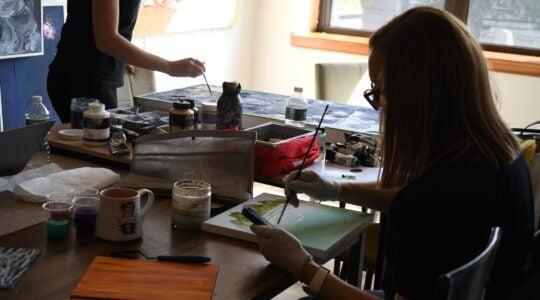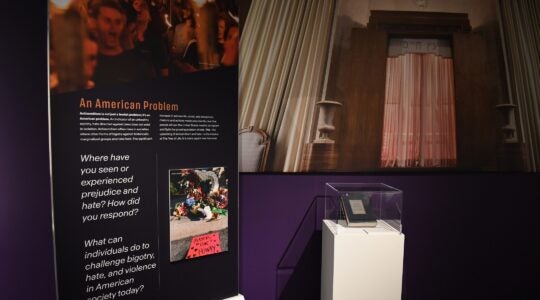A federal appeals court ruling allowing an eruv in Tenafly, N.J., has established a precedent that will discourage future lawsuits against eruvs elsewhere in the United States, supporters of the eruv say.
In the latest legal backing for the eruv, the 3rd U.S. Circuit Court of Appeals ruled last week that the Bergen County town discriminated against a group of Orthodox Jews who put up the symbolic boundary two years ago.
The eruv creates an area that allows objects to be carried outside of one’s home from sundown Friday to sundown Saturday.
The court decision is “a great victory [not just] for Orthodox Jews in particular, but for all religious Americans,” said Nathan Diament, director of the Orthodox Union’s Institute for Public Affairs, who wrote a “friend of the court” brief on behalf of the Tenafly eruv.
“The Tenafly eruv will stay up, religious bigotry has been defeated and America is better for it,” he said. “The court vindicated the proposition that local municipalities can’t manipulate its ordinances to keep out a group.”
The eruv created by the Tenafly Eruv Association — narrow, black plastic strips that line the side of a few hundred utility poles — may not be taken down until a final judicial decision.
Tenafly officials, who argued that allowing the eruv would constitute an unconstitutional favoring of one religion, filed a petition this week for a possible rehearing of its case. But Tenafly will not decide until a Town Council meeting this month whether to continue its legal battle, according to a town attorney.
“There is hope that the town will not take this any further,” said Chaim Book, a Manhattan attorney and treasurer of the eruv association.
The court’s decision is unlikely to be overruled on appeal, legal experts said.
“The decision will benefit the community,” said Joy Kurland, director of the Jewish Community Relations Council at the UJA-Federation of Bergen County and North Hudson.
While seeking to remove the eruv markers, the town has long allowed such items as house numbers, church signs and orange ribbons for student protests to be posted on the poles, the eruv supporters claimed.
“We … hold … that the Borough’s selective enforcement of its ordinance likely violated the [Constitution’s] Free Exercise [of religion] Clause,” a three-judge panel of the 3rd Circuit Court stated in its decision. “Even if there is some slight risk that a reasonable, informed observer might misperceive the endorsement of religion, there is a much greater risk that the observer would perceive hostility toward Orthodox Jews.”
An eruv, established by intricate Jewish law, in most major cities is a series of wires — existing utility wires or cords between poles put up by Jews familiar with halacha — that create a domain in which carrying is allowed on Shabbat. In the case of Tenafly, the phone wires were already in place. The eruv association affixed to the poles the plastic strips, known as lechis, that mark the poles as passageways.
Tenafly Borough Attorney Walter Lesnevich said the court ruling is “wrong on the facts. It sets an impossible standard on municipalities. We do enforce our ordinance on the poles.”
Nathan Lewin, an attorney for the eruv association, said an appeal to the full 11-member 3rd Circuit Court is the town’s most likely, and least expensive, remaining legal option. The town also could seek a return to federal court in Newark, as well as a review by the U.S. Supreme Court.
A reversal is improbable, said Marc Stern, director of the American Jewish Congress Commission on Law and Social Action.
“I don’t think it’s likely to be greatly appealing to the entire circuit [court],” he said.
“The refusal [by Tenafly] to allow this eruv was motivated by anti-Jewish animus,” Stern said. “Anti-Jewish animus is never an acceptable reason” for a municipal action.
While the court ruling technically serves as precedent only for other courts within the circuit, the decision is likely to be cited in similar legal cases elsewhere in the country.
The right to erect an eruv was upheld by courts involving Long Branch, N.J., and Belle Harbor, Queens, in the 1980s. Those challenges to local eruvs were raised by outside groups and not, as in the Tenafly case, by the municipality itself.
The Tenafly eruv association had obtained permission for the eruv from Cablevision and Verizon, which maintain the utility poles, and from Bergen County but not from Tenafly, on whose land the poles are located.
Tenafly, eruv supporters said, selectively enforced a 1954 ordinance that prohibits placing any sign, advertisement “or other matter” in the public right of way without permission.
The town’s action, the eruv supporters said, was aimed specifically at Orthodox Jews.
Scores of Jewish communities across the U.S. have put up eruvs, often creating similar controversies.
The issue in Tenafly, according to members of the community quoted in a New York Times article last year, created ill will in the town, fomenting open expressions of anti-Semitism by non-Jews and anti-Orthodox feelings among non-Orthodox Jews.
Book, a Tenafly resident for three years and spokesman for the eruv association, called the controversy “individuals against individuals” and said reports of a social schism were exaggerated.
“There were individuals in the nonobservant community who were very vocal” in support of the eruv, he said. “We had several non-Jews,” including Christian clergy, “who were very vocal in support.”
Residents of Tenafly with school-age children likely opposed the eruv, Book said, because it was thought to attract Orthodox families who send their children to private day schools and vote against public school budgets. Older members of the community “don’t like change of any sort,” he said.
Tenafly, like many Jewish communities, has used an eruv as a recruiting tool to grow.
The membership of Kesher, a newly formed Modern Orthodox congregation, has nearly tripled — from a dozen to 34 families — since the eruv went up, Book said.
Tenafly’s population is about 13,000. While it has a sizable Jewish population, possibly approaching 50 percent, Book said, the number of observant families that use the eruv is “very small” — about 50.
The eruv allows observant families to wheel their children to synagogue in carriages and carry their tallit bags on Shabbat, among other things.
Its plastic strips are unobtrusive, indistinguishable in photographs from plastic pipes that protect wiring.
“We lived in Tenafly a year before the eruv went up,” said Book, a father of three young children. “It was very difficult” on Shabbat. “For almost an entire year the only time my wife went to shul was on a holiday, when you don’t need an eruv.”
The eruv makes “life much easier,” he said. “My wife comes to shul every Shabbat.”
The New York Jewish Week brings you the stories behind the headlines, keeping you connected to Jewish life in New York. Help sustain the reporting you trust by donating today.




